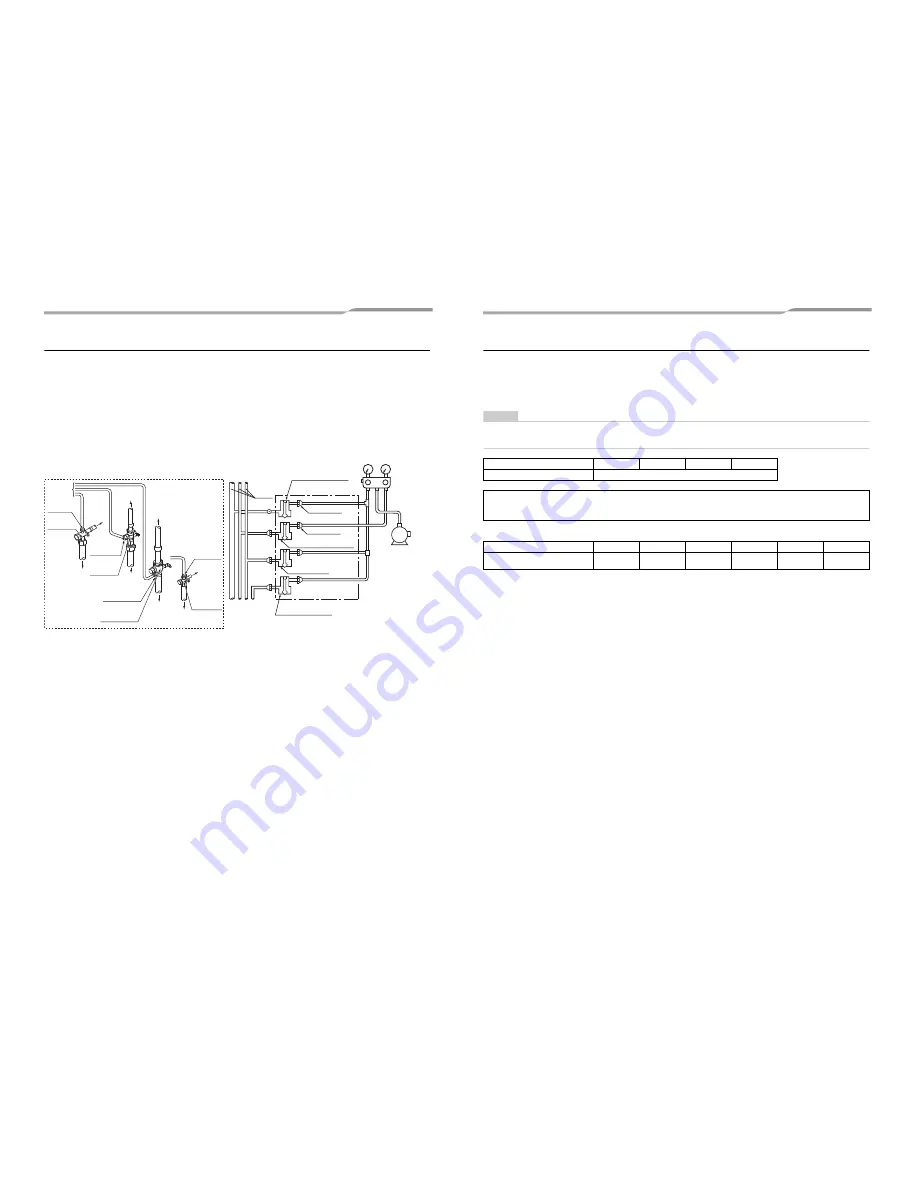
– 16 –
Vacuum drying
• Be sure to use a vacuum pump equipped with the counter-flow prevention function so that oil in the pump will
not flow back into piping for air conditioners. (If oil in the vacuum pump enters in the air conditioner with R410A
refrigerant, a problem may be caused in the refrigerating cycle.)
After finishing the airtight test and discharging nitrogen gas, connect the gauge manifold to the service ports of the liquid side,
discharge gas side, suction gas side, and balance pipe side and connect a vacuum pump as shown in the figure below. Be sure
to perform vacuuming for the liquid, discharge gas side, suction gas side, and balance pipe sides.
• Use a vacuum pump with a high vacuuming degree [-100.7 kPa (5 Torr, -755 mmHg)] and large exhaust gas
amount (40 L/minute or larger).
• Perform vacuuming for 2 or 3 hours, though the time differs depending on the pipe length. Check that all the
valves at the liquid side, discharge gas side, suction gas side, and balance pipe side are fully closed.
• If the pressure does not reach 100.7 kPa or less even after vacuuming for over 2 hours, continue vacuuming for
1 hour or more. If the pressure does not reach -100.7 kPa after 3 hours of vacuuming, stop vacuuming and check
for air leakage.
• If the pressure reaches -100.7 kPa or less after vacuuming for 2 hours or more, close the valves VL and VH on
the gauge manifold fully and stop the vacuum pump. Leave it as it is for 1 hour to confirm that the vacuuming
degree does not change.
If the degree of vacuum loss is large, moisture may remain in the pipes. In that case, inject dry nitrogen gas and
apply pressure to 0.05 MPa and perform vacuuming again.
• After finishing the above procedure of vacuuming, exchange the vacuum pump with a refrigerant canister and
advance to the additional charging of refrigerant.
• To protect the world's environment, do not release chlorofluorocarbons into the atmosphere.
• Do not do an air purge including used refrigerant.
P
V
L
V
H
Connected to
indoor unit
Main
pipe
Low pressure
gauge
High pressure
gauge
Brazed
Fully
closed
Fully
closed
Connected to
other follower
units
Balanced pipe side
valve fully closed
Service port
Vacuum pump
Gauge
manifold
Service port
Header outdoor unit
Fully
closed
To gauge
manifold
Liquid-side
service port
Liquid-side
valve
Piping at
site
Packed valve
of balance
pipe side
Ball valve of
suction gas side
Service port of
suction gas side
Piping
at site
To outdoor unit
To
outdoor
unit
Packed valve
details
To outdoor
unit
Service port
of balance
pipe side
To
gauge
manifold
To
outdoor
unit
Piping
at site
Suction gas side
valve fully closed
Liquid side valve
fully closed
Discharge gas side valve
fully closed
Service port of
discharge gas side
Ball valve of
discharge gas side
Piping
at site
Adding refrigerant
After finishing vacuuming, exchange the vacuum pump with a refrigerant canister and start additional charging of refrigerant.
Calculation of additional refrigerant charge amount
Refrigerant charge amount factory default does not include the refrigerant for pipes at the local site.
For refrigerant to be charged in pipes at the local site, calculate the amount and charge it additionally.
NOTE
If the additional refrigerant amount indicates minus as the result of calculation, use the air conditioner without additional
refrigerant.
Table 1
Outdoor unit type
MAP080
MAP100
MAP120
MAP140
Charging amount (kg)
11.0
Additional refrigerant
charge amount at local site
=
Real length of liquid pipe
×
Additional refrigerant
charge amount per 1 m
liquid pipe (Table 1)
×
1.3
+
Corrective amount of
refrigerant depending on HP
of co-operating outdoor units
(Table 2)
Liquid pipe dia. (mm)
6.4
9.5
12.7
15.9
19.1
22.2
Additional refrigerant amount / 1 m
liquid pipe (kg/m)
0.025
0.055
0.105
0.160
0.250
0.350
31-EN
32-EN
Summary of Contents for MMY-MAP0804FT8-E
Page 37: ...EH99889397 ...
















































